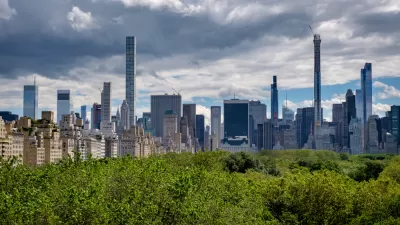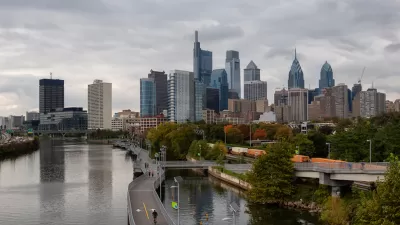Comcast recently released designs for a $1.2 billion skyscraper in Downtown Philadelphia. The building’s potential starkly contrasts the suburban model of commercial office parks.
Comcast has proposed a $1.2 billion, 59-story building designed by Norman Foster at 18th and Arch in Philadelphia. When it opens in 2017, the 1,211-foot-tall building will be the country’s eight tallest, and the tallest outside of New York and Chicago.
Inga Saffron writes that the building is a rebuttal to the bubble conditions of other high tech office parks. And yes, Saffron recognizes the irony of Foster's involvement with this potential sea change of commercial design ethos. "He's the same guy who is designing Apple's sprawling new headquarters on a 170-acre suburban site in Cupertino, Calif., a low-slung, four-story ring that reinforces the status quo.”
Rather, Saffron explains, the new tower is “a skyscraper version of the great, light-filled factory lofts of the early 20th century.” The program of the building is made all the more powerful but its position within the context of the city, where it will be “wedged into the unpredictable heart of Center City atop the region's densest transit hub.”
Moreover, Saffron is explicit about the lofty ambitions for the building: “The tower's simplicity is as potentially radical as Walter Gropius' Fagus factory was in 1913, because it recognizes that urban skyscrapers are not just for paper pushers, but also for collaboration and creativity.”
FULL STORY: Changing Skyline: Comcast tower a new symbol for technology

Alabama: Trump Terminates Settlements for Black Communities Harmed By Raw Sewage
Trump deemed the landmark civil rights agreement “illegal DEI and environmental justice policy.”

Planetizen Federal Action Tracker
A weekly monitor of how Trump’s orders and actions are impacting planners and planning in America.

Why Should We Subsidize Public Transportation?
Many public transit agencies face financial stress due to rising costs, declining fare revenue, and declining subsidies. Transit advocates must provide a strong business case for increasing public transit funding.

Understanding Road Diets
An explainer from Momentum highlights the advantages of reducing vehicle lanes in favor of more bike, transit, and pedestrian infrastructure.

New California Law Regulates Warehouse Pollution
A new law tightens building and emissions regulations for large distribution warehouses to mitigate air pollution and traffic in surrounding communities.

Phoenix Announces Opening Date for Light Rail Extension
The South Central extension will connect South Phoenix to downtown and other major hubs starting on June 7.
Urban Design for Planners 1: Software Tools
This six-course series explores essential urban design concepts using open source software and equips planners with the tools they need to participate fully in the urban design process.
Planning for Universal Design
Learn the tools for implementing Universal Design in planning regulations.
Caltrans
Smith Gee Studio
Institute for Housing and Urban Development Studies (IHS)
City of Grandview
Harvard GSD Executive Education
Toledo-Lucas County Plan Commissions
Salt Lake City
NYU Wagner Graduate School of Public Service





























